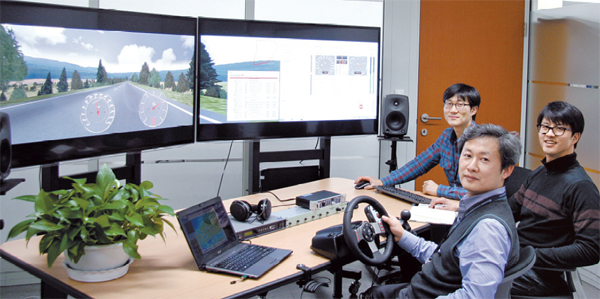Hyundai NVH2 team’s success based on some sound research

At the Hyundai’s test driving center at Namyang Institute in Hwaseong, Gyeonggi, last Friday, a specially designed Sonata spun out as Park Dong-chul, research fellow at Hyundai Motor turned the driving mode to “sport.”
At the same time, the engine started growling, the result of overlaying powerful engine sounds through the car’s audio system.
“As the powerful sounds are added according to the number of engine revolutions as if they are harmonizing with the original sound of engine, drivers do not recognize that separate sounds were added through the audio,” said Park.
“It was designed in a way that drivers will be able to hear the sounds they want by controlling the angle of acceleration pedal.”
The world of automotive sounds is evolving from technology to reduce noise and vibration to ways to create sounds.
Many tend to only think about engine noise.
However, there are a lot more sounds that occur in the vehicle, from doors and sunroofs opening and closing to turn signals.
In case of raindrops on top of the car, Hyundai Motor’s Equus gets eight points out of 10 from hearing experts, while other cars with crashing tin-roof sounds get four points.
Hyundai Motor’s NVH2 Research Team spends the whole year designing these sounds.
On the team are eight researchers, who used to be composers and songwriters, and they strive to create sounds that fit certain concepts.
Also, the team gets help from hearing experts, who pinpoint problem areas.
“Acoustically, the silence of libraries is rather more uncomfortable than natural noises.
The trend is to create a car with good sounds, not a car with silence,” said Park.
They often get sounds from nature as well. For instance, they utilize the characteristics of tiger growls for the engine sounds of sports cars.
After designing the “click” that occurs when a door is locked, they create the shape of the lock.
They even calculate the operating speed of parts because that affects the sound.
The NVH simulation device, worth more than 100 million won ($91,300), also plays a big role in designing the sound.
When researchers step on a plain-looking accelerator pedal under a desk, they can check sound changes according to road conditions, wind strength, speed and tire pressure.
“No sound is created by chance. Engineering is devotion,” said Park.
However, not all sound preferences are created equal as they can differ by country.
With turn signals, for instance, Koreans prefer soft sounds.
“In Germany, people prefer regular tick-tock sounds similar to mechanical sounds when operating indicator lights,” said a Hyundai spokesman.
European drivers tend to favor lusty engine sounds on acceleration, while many Koreans prefer quiet.
“ ‘Changing the world with sounds’ is the motto of our team,” said Park. “We take pride in creating a world with better sounds.”
By Kim Young-hoon [kjy@joongang.co.kr]










with the Korea JoongAng Daily
To write comments, please log in to one of the accounts.
Standards Board Policy (0/250자)